|
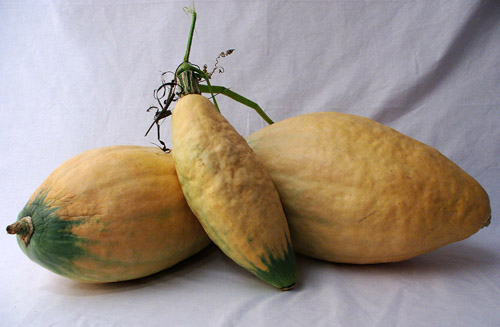
This squash was grown by the Arikara Indian tribe who historically occupied the region along the Missouri River in western North Dakota. They were known to the Sioux as "corn planters" and were well known to all for planting pumpkins, beans, corn and squash.
Arikara winter squash was introduced in the 1920 Oscar Will Seed Catalog … this variety came to famed seedsman Oscar Will via Melvin Gilmore who obtained seed from the Arikara at Ft. Berthold.
Gilmore, an ethnobotanist and historian is perhaps best known for his interview and transcription that resulted in a book we know as Buffalo Bird Woman’s Garden today.
Gilmore and George Will were friends and colleagues … often reading drafts of one another’s ethnographic works prior to publication.
Arikara winter squash was followed in 1922 by Arikara watermelon, which had the same provenance. Arikara squash is an extremely heavy producer of pink-salmon colored hubbard shaped fruits. Squash sizes range from a few pounds or more depending on soil nutrient levels. Produces well under stress. Dry farmed with great success. Average of 600 gm of fruit per plant with zero irrigation in coastal conditions. Needs lots of space to grow. Vines can reach an excess of 12'
Arikara is an excellent keeper. Some keep for over a year stored at a constant 55 F.
Excellent roasted and eaten like sweet potatoes or made into a rich, creamy soup.
A homestead type food. It grows well in extreme conditions, produces heavy and stores for up to a year.
Varieties:
Knife River Squash
Lots of interesting diversity in this landrace-type squash—shapes range from round to elongated to hubbard-type. Weights are more uniform, running mainly around 5 to 8 pounds. Color is usually salmon-pink to buff, with an occasional green fruit. The variety originated when three Indian tribes, the Hidatsa, Arikara and Mandan, were living in close proximity for protection, near the confluence of the Missouri and Knife Rivers. This is an excellent keeper growing on very vigorous vines. Superb flavor with a unique sweetness. 95 days.
La Madera
Early maturity rate. "We ate that squash. It was delicious! Two surprises: the skin was hard as a gourd! There was relatively little flesh but it had an exceptional flavor."
runner: yes fruit: Pink, creamy white, bluish spot on the umbilicus. Round, flattened on the pedicel side and slightly wilted on the umbilicus side. Ribs slightly marked, umbilicus protuberant and crowned. fruit size: 25 to 35 cm in diameter. weight: 3 to 10 kg. epidermis: Smooth, very hard and some corky asperities. flesh: Orange thick and firm. description / information: Variety of very good quality and easy culture. It offers from 2 to 6 fruits per foot. growth: 110 to 140 days. use: soup, gratins, purees, confectionery, jam.
conservation: 4 to 10 months.
|
|
Arka Suryamukhi is a family favourite pumpkin variety, very popular in southern India. It was bred by the Indian Institute of Horticultural Research in Bangalore, and because of it's success, large quantities are now exported to the Middle East. The small fruit are round and flattened with large ribs and a beautiful orange rind. The medium sized vines produce high volumes of fruit ranging in size from 1kg to 2kg. Inside, the bright yellow flesh is thick, sweet and very yummy. Easy to understand why it is favoured in it's homeland.
|
|
Produces huge, thick, peach-orange skinned squash somewhat like the Jarrahdale. Flesh is orange, very tasty, and excellent for pies and desserts. Fruits regularly weigh up to 15 pounds and keep well. Australian Butter Squash is from Diggers Garden Club, Australia.
|

Known as the North Georgia Candy Roaster squash.
Here is a smaller strain of Candy Roaster from northern Georgia. This type of squash is famous among the people of the Southeast. Pink, banana-shaped fruits have a blue tip and weigh around 10 lbs. Delicious, smooth orange flesh is perfect baked, fried and makes great pies; hard to find and quite beautiful.
Likely hybrid of Pink Banana Squash
Seed reviews: Grown successfully all over the USA, Brisbane Australia, and England.
History:
Rare heirloom variety. Originally cultivated by the Cherokee Indians in the Appalachian Mountains of the southeastern portion of the United States. It is still most often grown in parts of northern Georgia, North Carolina, and Tennessee. Like many of the winter squashes enjoyed in America, this one continues to be cultivated because of seeds provided by Native Americans. The North Georgia Candy Roaster Squash is part of a group of candy roaster squashes that were all cultivated by the Cherokee and vary in shape from oblong to round.
There is a North Georgia Candy Roaster which is a small ( 10 lb) variant of the Pink Banana Squash. There is also the Candy Roaster ( sometimes called the Georgia Candy Roaster which is a big (60 lb) variant of the Pink Banana squash. Then there is the Candy Roaster sold by Fedco which is a Buttercup type squash said to originate in North Carolina.
Variety:
heirloomseedsupply Candy Roaster
southernexposure Candy Roaster
|
|
Heirloom from the Hidatsa native people who gardened on the Missouri River near a place called at the time “Like a Fish Hook”. Hubbard-type or french pumpkin type fruit with reddish pink skin. Hubbard-type or french pumpkin type fruit with reddish pink skin. Excellent keeper. Thick orange flesh at least one inch very flavorful. Outstanding ingredient for pies but also delicious by itself. 100 days.
|
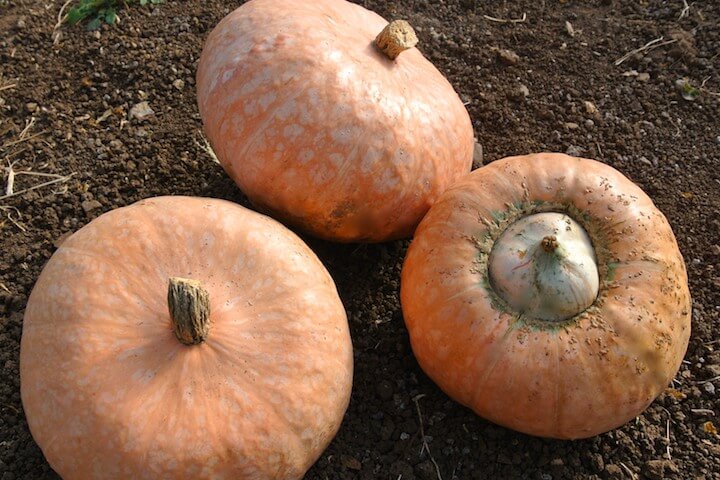
Lower Salmon River Squash is on the short list of heritage Pacific Northwest winter squash varieties. Grown in and around Idaho’s Lower Salmon River, possibly for generations, it is uniquely adapted to the bioregion. Plants seem to love it here and are pretty high yielding. Deep orange sweet flesh is flakier and drier than Sweet Meat. Delicious for pies and soup or even served sliced as a side dish with butter. The salmon pink colored skin is very thick with light mottling. Almost woody rind helps the fruit store for up to one year under ideal conditions and discourages mouse and deer nibbling. Hard rind can be susceptible to cracking if over-watered late in the season – harvest before the fall rains begin. Fruit are generally 3-10 lbs, with an occasional jumbo 15 pounder. Some fruit have a more buttercup shape (more turban like) and others have a more kabocha shape (less turban like). We select for both in our stock seed, liking both shapes and the slight thematic variability is part of its integrity. During squash tasting events held in December 2014 by the Culinary Breeding Network, Lower Salmon River was a big flavor winner.
Seed Review:
Great Performer on 09/22/16 by Lyn in Westcliffe, Colorado
I grew this squash at 8500 ft with lots of windy days and below 50 degree nights. The plants thrived and survived late season light frosts well. They produced well and the fruits matured. Excellent high altitude selection.
Varieties:
Theron
This variety produces enormous fruits up to 25 kgs. The color of the epidermis is pink-salmon. The plants can reach an amplitude of 10 meters and carry on average three fruits. The fruits are delicious to cook and can also be used to feed farm animals.
This traditional variety was created by Theron Atkinson in the 1940s in the USA. It is probably the result of a cross between a Hubbard type and a Banana type. It was reintroduced commercially in 2013 by Adaptive Seeds in Washington State.
|
|
|
|
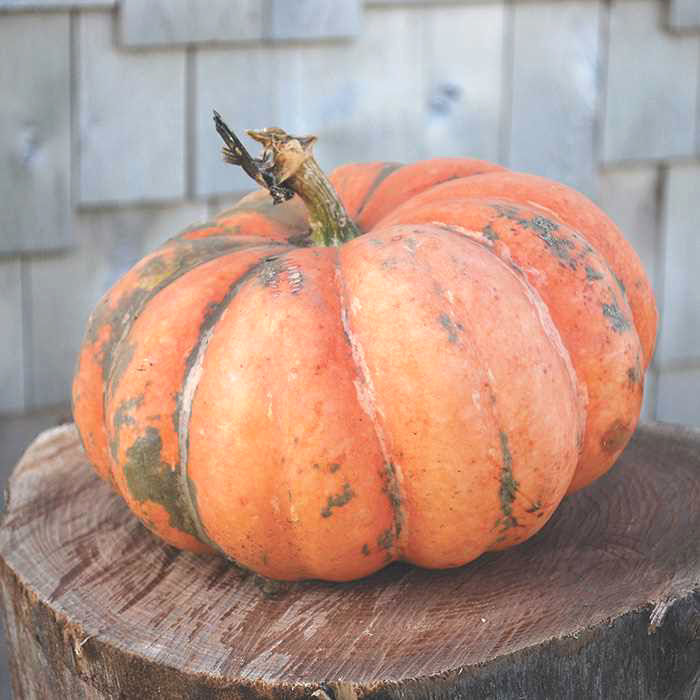
Pretty color combined with superb eating quality. These light pink to salmon 4 to 8 pound squash are the preferred variety for making a traditional Brazilian shrimp and winter squash dish “camaraona moranga” or shrimp in a squash. Great for fall decorations, but also stores very well. Also known as Pink Pumpkin. Moranga translates to squash in Portuguese.
Seeds Review:
Grown successfully in Ontario, Canada, Texas, California, Michigan, New Hampshire.
Varieties:
Moranga Exposicao
Very decorative Fruit from Brazil. Plant: vine; Fruit: pink-darkred, ribbed, flatround, Size: (D): 25 - 30 cm Flesh: orange;
Usage-Recommendation: Soup, Puree, Oven, Steam, Deep-Fry
Storage time: +++
Weight: 1.5 kg - 3.0 kg Maturity: 100 days
Boliviana Pumpkin
Very nice variety, originating from Bolivia, introduced on the marke by KCB-Samen, and named by Mathis-Hof . Plant: vine; Fruits: round, flat on handle-side, pointed on the other, ribbed, nicely orange coloured; Size (DxH): 17 - 19 x 15 cm; Flesh: orange, of good quality; Usage-Recommendation: Soup, Puree, Oven, Steam, Deep-Fry
Storage time: +++
Weight: 1.0 kg - 1.5 kg
Maturity: 110 days
Garbo
Garbo is a pumpkin variety of recent European breeding with links to a variety from South America. This variety was named after the 1930's actress Greta Garbo, because of it's beauty. It is a great looking pumpkin, round and flattened, heavily ribbed with a smooth rind who's colour range includes shades of orange, red and terracotta. The medium length, tall vines are heavy producers of fruit ranging from 2kg to 4kg in 95 days. Inside, the yellow/orange thick flesh is moist, smooth and stringless, medium sweet with great flavour.
|
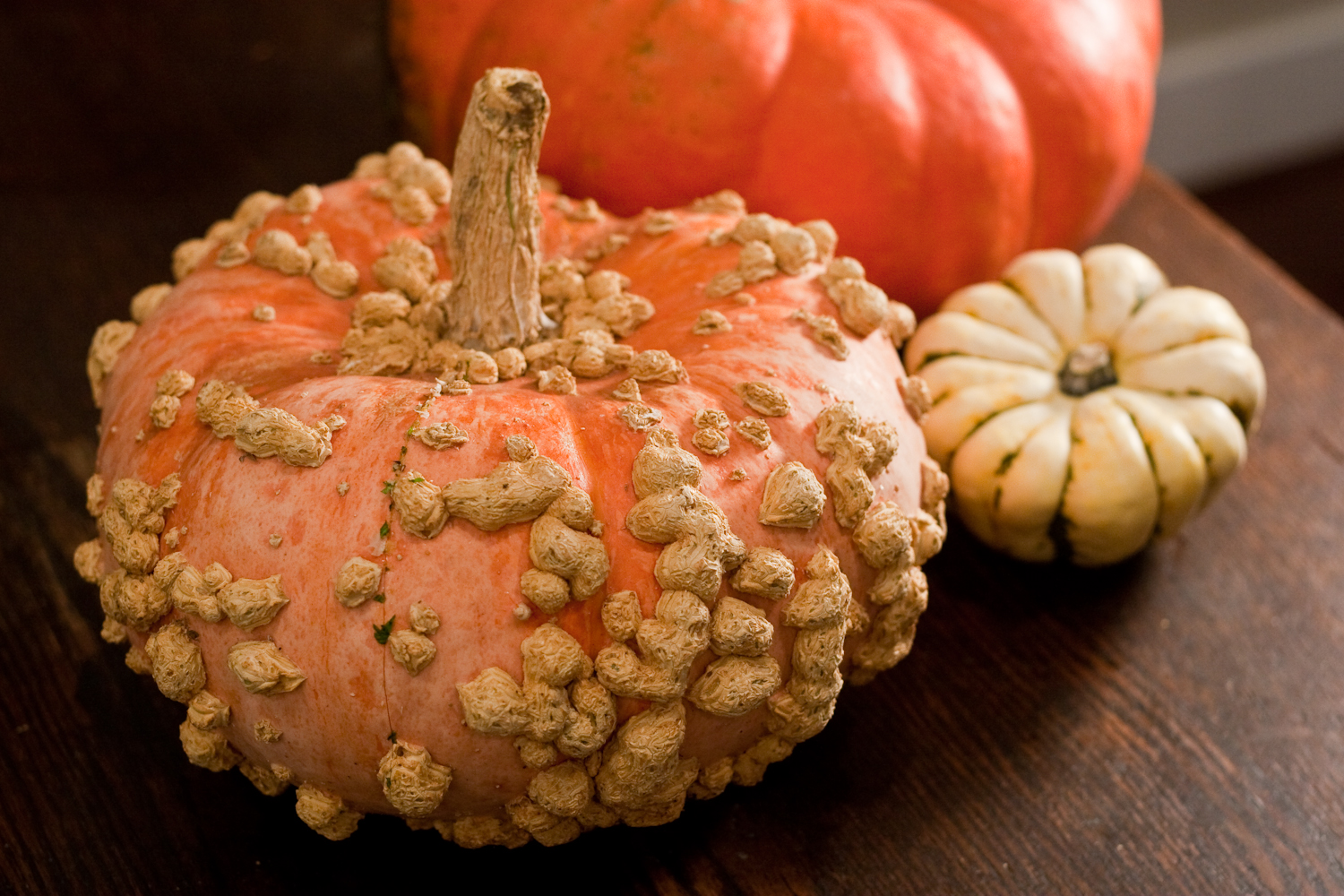
Very good for cooking and pies. Also known as Galeux d’Eysines.
Description/Taste
Galeux d’Eysines squash has salmon-peach colored skin that is covered in peanut-shell like protrusions. When maturing from green to orange, sugars in the flesh begin leeching through the skin which is what causes its unique, wart-like bumps. As the sugar content grows, the more nodes appear on the outside of the squash. The more peanut-shell like protrusions, the sweeter the squash. The flesh is a bright orange with a medium-sized seed cavity. Galeux d' Eysines squash has a sweet flavor, with a smooth velvety texture free from the fibrous strings found in many other squash varieties. Galeux d’Eysines can grow to be between ten and twenty pounds.
Ethnic/Cultural Info
The Galeux d’Eysines is mentioned in Vilmorin-Andrieux’s famous album, Les Plantes Potagères, dating back to 1883, also mentioned in the book "Vegetables" Vilmorin-Andrieux (1885). Its name, a nod to its unique appearance and point of origin, is believed to have originally been, Borde Galeux d’Eysines, which in French translates to mean, “Embroidered with scabs from Eysines.”
Geography/History
Galeux d’Eysines squash is an heirloom variety which originated in Eysines, France in the nineteenth century. A variety that was shaped like a club is believed to have existed in 1880 and was known as Corge Brodee de Thoumain. The Galeux d’Eysines is thought to have made its way to the United States first in 1996 after seeds for it were brought back by squash expert and author Amy Goldman from Foire aux Potirons a pumpkin festival in Tranzault, France. Still a unique variety in America it can be found when in season at farmers markets and in home gardens. The plant is a prolific producer and is hardy to a variety of growing conditions.
Harvest the 10-20 lb. mature fruits in about 90 days.
This pink-skinned pumpkin is lighter in density than most other pumpkins and is mild and fluffy when baked. It can be eaten straight out of the oven and is also good for soups and stews and baked with a pot roast.
|
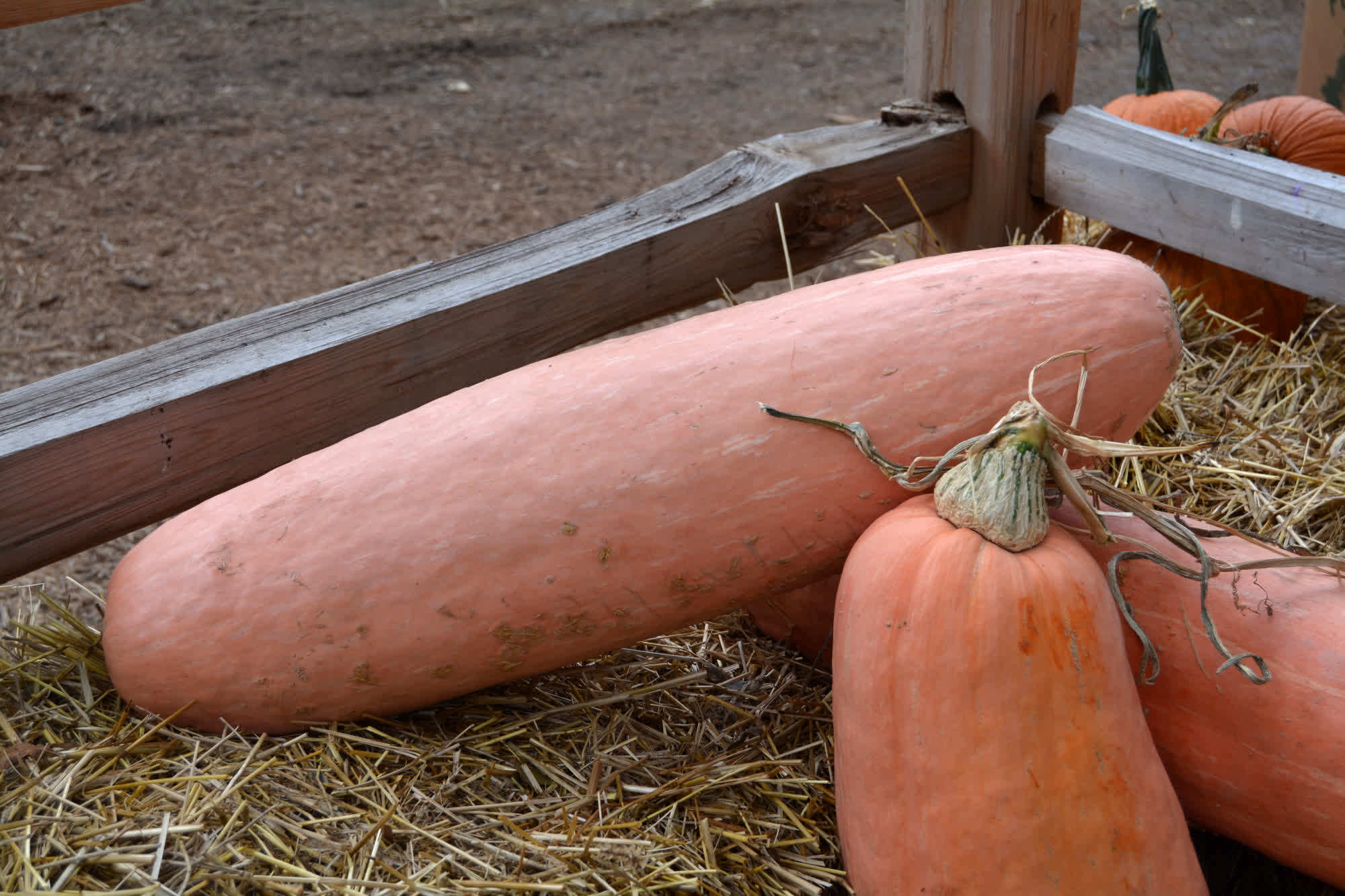
Very suitable for cooking. Variety native to the United States, very popular among the pioneer families in the 19th century. Still very much appreciated today, especially in California. The pumpkins have a length varying from 30 to 120 cm, with weight from 5 to 20 kg. The pulp is intense orange and quite sugary taste.
Suitable for cakes and baked. Storage capacity from 3 to 6 months.
Pink Banana squash are cylindrical in shape and imposing in size, reaching up to 2 to 3 feet in length and averaging 8" in diameter. Though the average weight is about ten pounds, a heavy banana squash can weigh up to 40 pounds. Their thick-walled rind, when ripe is salmon pink in color. The flesh: thick, firm, dense and meaty with a true pumpkin orange color. Its seed cavity holds few and small seeds. The cooked flesh of the banana squash has a stronger flavor, fragrant, rich and earthy sweet.
The flesh is finer grained and sweeter than a standard pumpkin. When found commercially at the grocery store you generally see this sold in chunks covered with clear plastic wrap instead of whole. Instead of pumpkin pie for holidays, we traditionally ate squash pies made by Great-Grandma Barlogio using Pink Banana Squashes.
The beautiful, smooth outer skin is very versatile and can be used for many squash dishes. This variety is over 100 years old. Popular on the West Coast; large yields.
Geography/History
Squashes of Cucurbita maxima can trace their origins back to South America and made their way to North America sometime after 1492. Seeds from an archaeological site in Peru matched the distinct identity of today's Banana squash cultivar. It would be traded and traveled to other regions within the Americas, yet maintain its identity as a true New World crop. The family of Banana squashes were introduced into the United States by R.H. Shumway in 1893 under the name of "Banana Squash" and "Plymouth Rock". Though the Shumway seed catalog would be the initial Banana squash orientation within the U.S., other seed catalogs would soon follow and by the early twentieth century the Banana squash was becoming a popular winter squash variety.
The traditional variety had a blue-gray epidermis striped with orange becoming pink-cream when ripe. By the 1900s, Aggeler and Musser from Los Angeles developed three lines: a yellow-orange variety, a blue-gray variety, and a pink variety.
More Info
Varieties:
Pastila-Champagne Vanilje
(Fruit Candy Champagne) From Russia. Average weight 3-4 kg. / 6.5-9 lb. Pink or bicolour skin - pink and grey-blue. Medium thick, orange flesh. Advertised as having vanilla aroma, and surprisingly sometimes it really has a touch of vanilla/milk flavour, when steamed (when baked loose that flavour and becomes much like 'Pink Banana'). Very good to excellent taste. 95 days.
Friedrich Nietzsche
This pinkish banana squash with excellent taste is an old variety of European heritage, probably German. It is an elongated fruit, of various lengths with reddish-orange rind, often with a green point on the end. The bright yellow flesh is thick, moist and medium firm with a mild flavour. Should be good in baking (scones, bread etc.). Whilst the seeds do run the length of the fruit, the cavity is only small which means there is a good amount of flesh. The large vines produce fruit ranging from 1.5kg to 4.5kg in around 105 days.
|
|
Musquee De Provence Hybrid(?) This yellow-orange squash has a smooth texture and works well in soups–perhaps in place of butternut squash. It’s got a grey-ish haze to its orange color and the shapes are usually short and squat.
Similar to the Red Kuri and Buttercup varieties, this yellow-orange squash has a smooth texture. Heisler suggests using it as an alternative to butternut squash in pureed soups. Flavorful and light when baked, it’s also good in pies, bread and muffins.
|
|
F1 Hybrid, possibly close to Indian Doll F1.
Orange flesh has excellent eating quality. Average weight is 30-40 lbs. Developed at the request for a pink pumpkin to a New York grower.
|
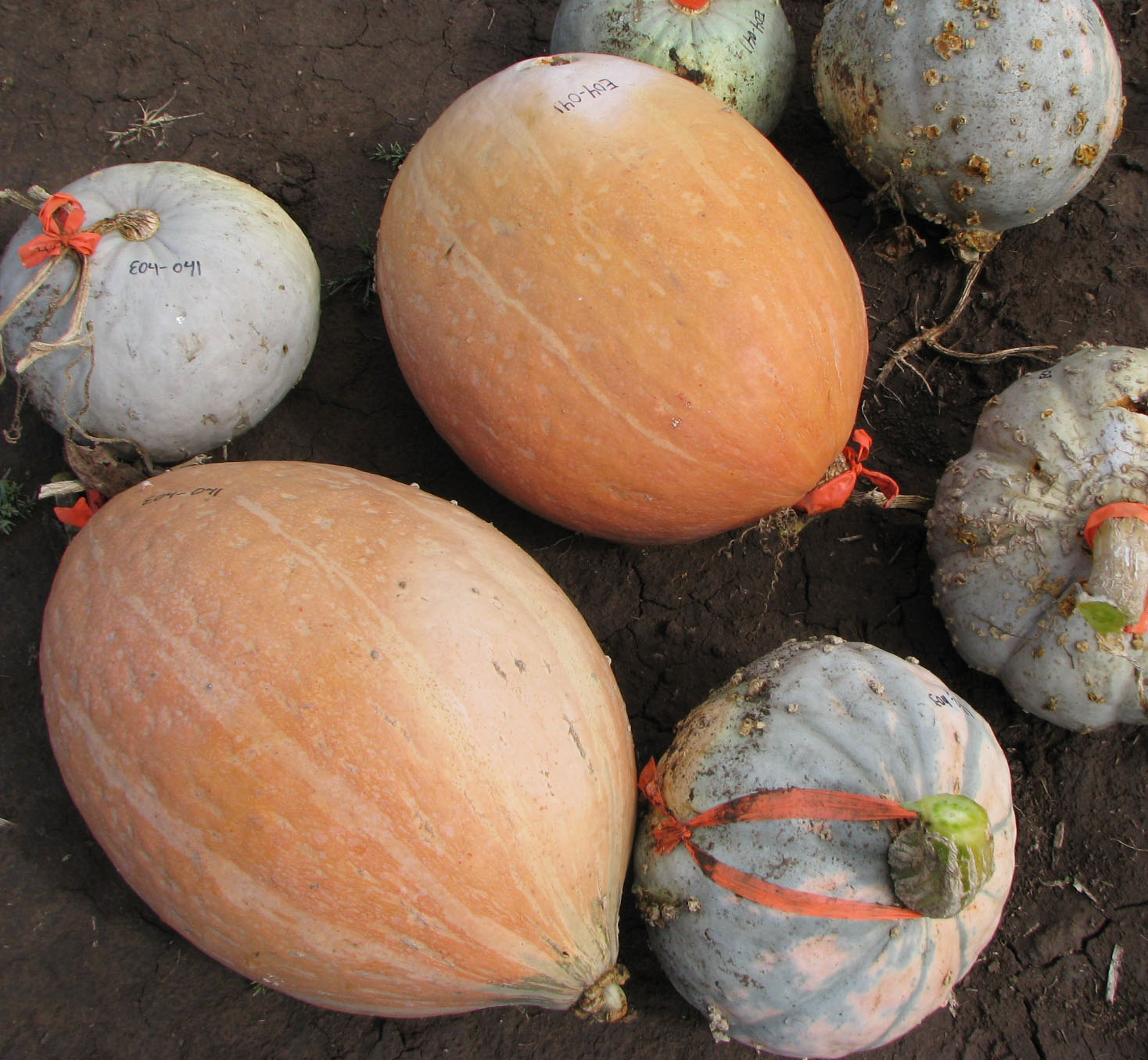
Also known as Rio Lucio Calabaza. Fruits vary in size and shape, 2-25 lbs. Skin is pinkish to deep orange and green, can be mottled with all shades appearing. Can be deeply ribbed. Flesh is dense and sweet, yellow to orange. Raised at 7500 feet elevation in Rio Lucio, New Mexico. There is a great variety in shapes, colors and types of squash, making them fun to grow. Growing pumpkins can be a great project for kids. The vines need plenty of room to sprawl, although some can be supported on a trellis. Summer or winter squash or pumpkins should be sown indoors in flats in short season areas, 3-4 weeks before the night soil temperatures have warmed up. Seedlings should be gradually hardened off. Plants prefer rich, compost enriched soil. They will cross pollinate within their species. After harvest they should be ripened for 30 days in a cool location.
Important Info : The vines prefer enriched soil and need plenty of room to sprawl. Go easy on the fertilizer as you will end up with all vine. They will cross pollinate within their species.
|
|
|
 MBZ
MBZ
